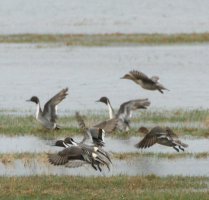 Bildrechte: H.-J. Kelm
Bildrechte: H.-J. KelmThe Elbe Valley from March to May
In March, the number of visiting birds is already dwindling, but many long-distance migrants make a stopover on the Elbe marshes.
These include the Bewick’s swans (Cygnus bewickii), northern pintails (Anas acuta), northern shovelers (Anas clypeata), common teals (Anas crecca) and garganeys (Anas querquedula), but also a great many wading birds such as Eurasian curlews (Numenius arquata), common redshanks (Tringa totanus), greenshanks (Tringa nebularia), wood sandpipers (Tringa glareola), green sandpipers (Tringa ochropus) and ruffs (Philomachus pugnax). Most of them continue their journeys northwards and eastwards, and only a few pairs of Eurasian curlews (Numenius arquata), redshanks (Tringa totanus) and black-tailed godwits (Limosa limosa) breed successfully in the Elbe valley.
At this time, the grey heron colonies (Ardea cinerea) are a hive of activity, and the white-tailed eagles (Haliaeetus albicilla) have already established their territories. The ‘neighing’ mating calls of the red kites (Milvus milvus) can be heard once more, and the pinewoods on the old dunes ring to the calls of the woodlarks (Lullula arborea).
The various bodies of water in the region are also springing back to life. Whereas the spawning season of the moor frogs (Rana arvalis) is quite short, one can hear the loud calls of the European tree frogs (Hyla arborea), natterjack toads (Bufo calamita) and fire-bellied toad (Bombina bombina) until the end of May – especially at night. And the robust marsh frogs (Rana ridibunda) continue to make themselves heard until August, both in the daytime and at night.
Most of the white storks (Ciconia ciconia) return from their winter quarters in April. Between the beginning and middle of May, the last of the long-distance migratory species have arrived. These include endangered species such as the red-backed shrike (Lanius collurio), barred warbler (Sylvia nisoria), European nightjar (Caprimulgus europaeus), Eurasian wryneck (Jynx torquilla) and ortolan (Emberiza hortulana).
 Bildrechte: H.-J. Kelm
Bildrechte: H.-J. KelmIn March northern pintails make a stopover on the Elbe marshes.



 deutsch
deutsch english
english